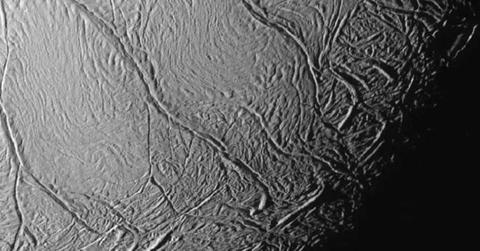Giant Fault, Concealed Ocean on Saturn's Moon Identified as Prime Area in Search for Extraterrestrial Life

These surface features have been informally referred to by imaging scientists as "tiger stripes" due to their distinctly stripe-like appearance when viewed in false color.
New research has unveiled a fascinating connection between the lateral movement along distinct "tiger stripes" on Enceladus, one of Saturn's moons, and the eruption of ice crystal jets from its icy surface.
This discovery holds promise in unraveling the mysteries of Enceladus's subsurface ocean and its potential habitability.
The tiger stripes on Enceladus, comprising four parallel fractures near its south pole, were initially spotted by NASA's Cassini spacecraft in 2005.
These fractures serve as channels for "cryovolcanism," expelling ice crystals thought to originate from the moon's hidden ocean. Consequently, a significant plume of material gathers over Enceladus's south pole.
Both the brightness of this plume and the activity of its jets exhibit a discernible pattern synchronized with Enceladus's approximately 33-hour orbit around Saturn. Scientists suspect that tidal stresses on the moon prompt an increase in jet activity.
However, the existing theory fails to explain why the jets peak in brightness hours after tidal stresses reach their maximum or why a secondary, smaller peak occurs shortly after Enceladus's closest approach to Saturn.
A novel numerical simulation mimicking Enceladus's tidal stresses and the motion of its tiger stripe fractures points to a phenomenon similar to what occurs along the San Andreas fault, aligning with jet activity patterns.
Lead researcher Alexander Berne, a PhD candidate at Caltech, elaborated on their findings. Their sophisticated numerical model accounts for various factors influencing slip along Enceladus's faults, such as friction, which is sensitive to both compressional and shearing stresses.
- What Lies Beneath: NASA Scientist Believes Aliens May Have Found 'Perfect' Hiding Spot in Earth's Oceans
- Global Threat: Russia Insider Warns West of 'World War Using Nuclear Weapons' Amid Escalating Support for Ukraine
- Countdown to Disaster? Ex-NATO Official Warns Russia, Iran and China Could Wage WWIII in Just Years
The simulation accurately replicates observed variations in plume brightness and surface temperature, indicating that jet activity and plume brightness fluctuations stem from strike-slip motion over Enceladus's orbit.
Berne and his team discovered that frictional mechanics govern motion along the interfaces of Enceladus's tiger stripes, causing periodic sliding and locking of these fractures during the moon's orbital cycle. This lateral motion corresponds with jet activity, suggesting that variations in jet activity are influenced by the presence of 'pull-aparts' along the faults.
Never miss a story — sign up for the Front Page Detectives newsletter. Be on the scene the moment news breaks.
The team's research challenges previous models of how Enceladus's tiger stripes open, suggesting a different mechanism involving lateral motion. This finding underscores the crucial role of tides in shaping Enceladus's evolution on various timescales, potentially influencing the formation of geologic features observed around its southern pole.
Enceladus's concealed global ocean has positioned it as a prime candidate for extraterrestrial life exploration. The research and modeling conducted by Berne's team offer additional support for this hypothesis by shedding light on subsurface material transport pathways.
While the conclusions drawn from the computer simulation await confirmation through direct observations, Berne emphasizes the importance of geophysical measurements at Enceladus. Such data could validate their hypotheses and provide insights into the moon's dynamics and potential habitability.
Published in the journal Nature Geoscience, this research marks a significant step towards understanding the complex dynamics of Enceladus and its implications for the search for life beyond Earth.
Become a Front Page Detective
Sign up to receive breaking
Front Page Detectives
news and exclusive investigations.
